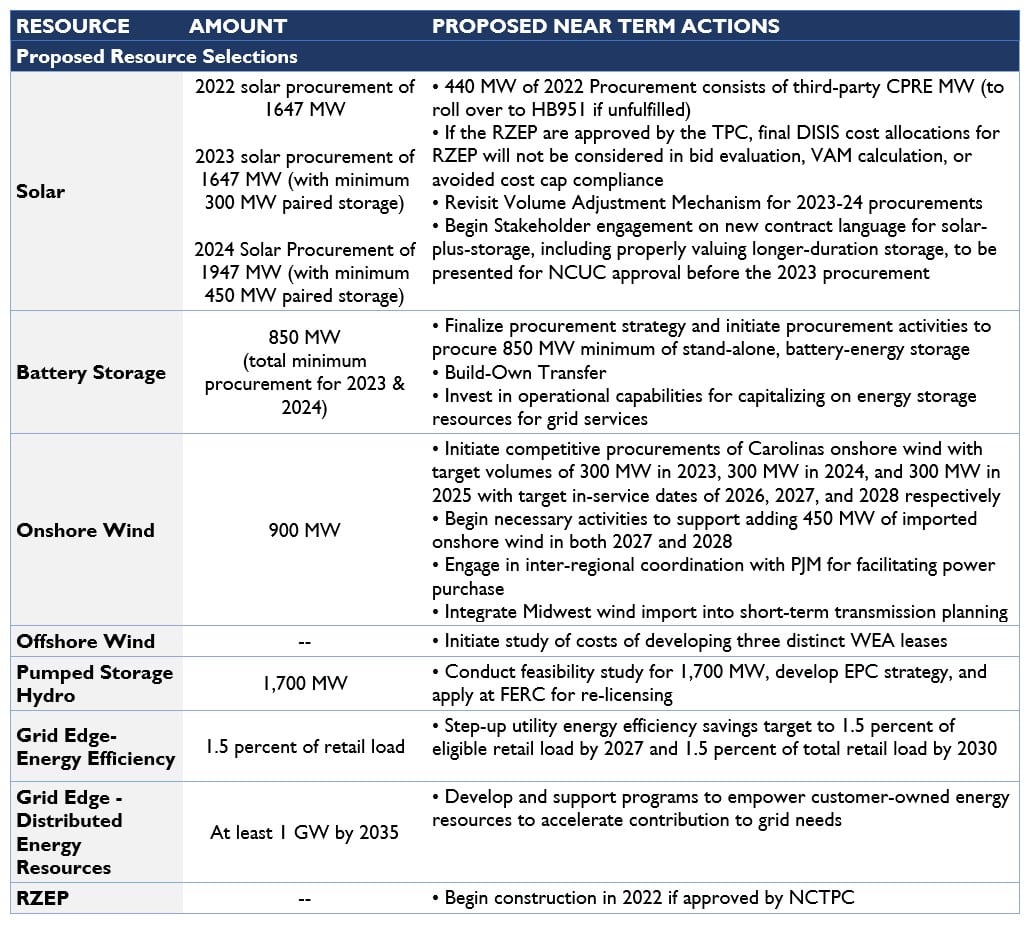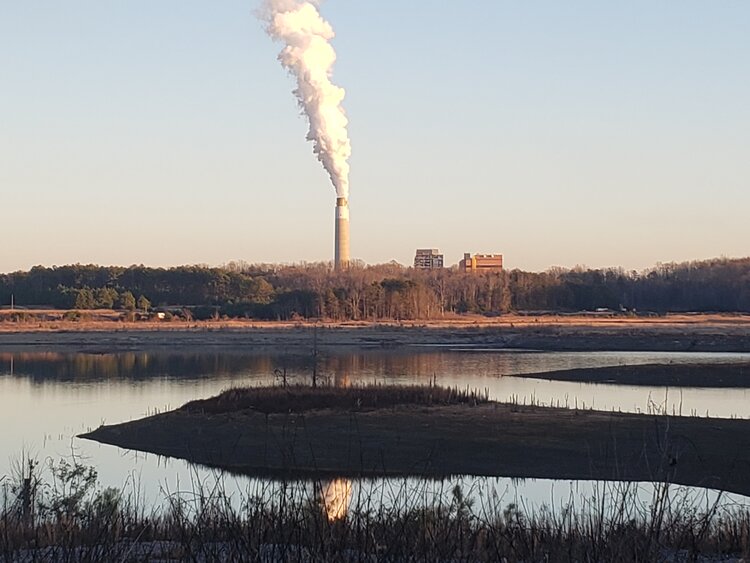On October 24, all intervenors’ post-hearing filings were due to the NCUC. These are the final step where intervenors tell Commissioners what we want to see in the final Carbon Plan. We at SACE joined co-intervenors in several of these filings, so here’s an overview of those, and where the process goes from here.
Quick background refresher
Way back in 2021, the North Carolina legislature passed HB 951 requiring, among other things, that the state’s major utilities (both owned by parent company Duke Energy) reduce carbon emissions by 70% from 2005 levels by 2030 and achieve net-zero by 2050. To do so, the North Carolina Utilities Commission (NCUC) was tasked with developing a Carbon Plan by the end of 2022. That is a relatively short timeframe for such a task, but the NCUC laid out a process that included Duke-led stakeholder meetings, a timeline for Duke and intervenors to file modeling and propose resource portfolios, and a hearing that ended up taking a full month so that Commissioners and intervenors could hear directly from and ask questions of experts on a variety of topics ranging from electricity system modeling, electric transmission, energy efficiency and demand-side measures, and the potential rate impacts of different portfolios.
For more background, see our previous posts on the process set up by the NCUC, Duke’s proposed Carbon Plan, and our own proposed Carbon Plan.
CLEAN Intervenors join others in filing a Joint Brief and Partial Proposed Order
The “Coalition of Low-Cost Energy And Net-Zero Intervenors” or CLEAN Intervenors, which includes SACE, NRDC, and Sierra Club, represented by SELC, and NCSEA, joined other intervenors (CCEBA, CPSA, and MAREC Action), to file a 29-page Joint Brief and Partial Proposed Order for consideration by the NCUC as it develops its final 2022 Carbon Plan. Here is a summary of the discussion, arguments, and recommendations presented in those two filings, as well as the proposed near-term execution plan recommended that the NCUC adopt.
It is premature to discuss delaying 2030 carbon reduction target. HB 951 stated that the Commission could delay the 70% reduction by 2030 target under certain circumstances, but the requirements for delay haven’t been met.
While several portfolios were presented to the Commission that did not achieve the 2030 target, the Commission should only consider modeling where that 2030 target was met. Five portfolios that meet the 2030 target were presented to the Commission by various intervenors, including only one of the four portfolios suggested by Duke and two by Synapse that were developed for NCSEA, SACE, NRDC, and Sierra Club. Those two scenarios were found to cost less and make greater use of renewable resources and energy efficiency than the portfolios presented by Duke, even when accounting for assumption changes to be able to compare the portfolios as apples-to-apples.
HB 951 requires that the Carbon Plan chart the least-cost path to the 2030 and 2050 carbon-reduction requirements. Two key metrics used in least-cost planning are the system cost and risks, including fuel price risk, execution risk, stranded asset risk, and risk associated with non-commercial technologies. Therefore a Carbon Plan that minimizes those risks will be in compliance with HB 951 least-cost planning requirements, and also be a “least regrets” plan.
Intervenors summarized common critiques of the modeling Duke presented to the Commission. Those critiques include that Duke delayed coal retirement dates beyond the economically optimal retirement dates; replaced economic plans to build energy storage with uneconomic gas plants; segmented the analysis into smaller time horizons so that the model could not optimize for the lowest cost over the entire time period; and constrained solar and storage resources without justification.
The filing also provides an overview of the different interpretations of potential for execution risk by various experts that testified during the Carbon Plan hearing. For example, does a portfolio that relies on nuclear technologies that are not commercially available today have a higher or lower risk of being executed than a portfolio that proposes to increase the amount of solar and storage added to the grid above levels Duke has achieved historically? The proposed near-term execution plan presented in this filing is “least-regrets” because it trades quantifiable near-term execution risk for largely unquantifiable long-term reliance on uncertain potential resources. If those uncertain potential resources become available, they may still be added to the grid at that time, but customers are not exposed to the potential that they are not yet available or they are a much higher cost at the time that they are needed.
The passage of the Inflation Reduction Act (IRA), which includes tax credits for proven clean energy resources like solar and wind as well as both tax credits and rebates for energy efficiency measures, makes a Carbon Plan that includes more of these resources is less risky and less costly than one that relies on speculative resources like small modular nuclear.
Proposed Near-term Execution Plan, a Least-regrets Strategy
Based on all the modeling presented to the NCUC that meets the 2030 target, intervenors signed onto this joint brief recommend the Commission adopt the no-regrets near-term execution plan presented in the table below.

Partial Proposed Order
A proposed order is a suggestion for how the NCUC could draft a final order in its Carbon Plan. This proposed order is partial because intervenors submitted separate, different, proposed orders on a few additional topics particular to their interests.
Here is a list of what this partial proposed order suggests the NCUC include in its final order:
- A list of Accepted Portfolios that are reasonable for the NCUC to consider as it develops the 2022 Carbon Plan, including two by Synapse for CLEAN intervenors and Portfolio 1 and P1-Alt modeled by Duke Energy.
- Deny Duke’s request that Portfolios P2-P4, and Supplemental Portfolios 5 and 6 be deemed reasonable for planning purposes.
- Direct Duke to pursue the near-term execution plan in the table above.
- Have no findings on the reasonableness or prudence of the long-lead time resources described in Table 3 of the Executive Summary of Duke’s proposed plan.
- Direct Duke to perform additional modeling that takes into account the impact of the IRA on demand-side and supply-side resources.
- Direct Duke to include impacts of the IRA in modeling that will inform the 2024 Carbon Plan.
- Direct Duke to supplement the reports it is already providing to the Commission on its efforts to obtain funding through the Infrastructure Investment and Jobs Act (IIJA) with its efforts to obtain funding or financing under the IRA.
- Direct Duke and an independent technical advisory committee to study the achievability of higher interconnection rates and advise on measures that could expedite the interconnection process.
- Direct Duke to include a range of energy efficiency savings in its next Carbon Plan update filing: 1% of total annual sales, 1.5% of eligible sales, and 1.5% of total sales.
- Direct Duke and the existing Energy Efficiency (EE) Collaborative to work together to find an appropriate method for modeling energy efficiency as a selectable resource.
- Deny Duke’s request to change the definition of low-income customers to 300% of the Federal Poverty Level.
- Direct Duke and the EE collaborative to submit a proposal on revisions to the cost-recovery mechanism to evaluate customer-sited programs on par with zero-carbon supply-side alternatives.
- Direct Duke to adopt more reasonable assumptions for customer adoption of self generation resources.
- Deny Duke’s request to begin near-term resource development for offshore wind at the Carolina Long Bay site. Instead the Commission would hire an independent third-party to evaluate the three available offshore wind lead areas.
- Open a generic docket to examine how to synchronize resource planning and transmission planning, and apply proactive multi-value transmission planning in North Carolina, including by integrating the FERC-jurisdictional NCTPC process with the Commission’s carbon planning process or other transmission planning reforms.
- Approve Duke’s approach to accounting for the emissions from new out-of-state resources.
- Direct Duke to provide an annual update on progress made toward meeting carbon reduction requirements.
CLEAN Intervenors’ separately filed another Partial Proposed Order
In addition to the recommendations in the Partial Proposed Order described above, CLEAN Intervenors (which again is SACE, NRDC, and Sierra Club, jointly with NCSEA) submitted a separate filing to recommend that the Commission include the following in its final 2022 Carbon Plan order.
- Direct Duke to make use of RMI‘s Optimus model or another similar financial model to analyze the impacts of proposed portfolios on ratepayers.
- Direct Duke to include in future modeling analysis of North Carolina joining the Regional Greenhouse Gas Initiative (RGGI).
- Deny Duke’s request that only Duke and the Public Staff develop revisions to the Commission’s Integrated Resource Plan (IRP) rules.
- Deny Duke’s requestion that Duke and the Public Staff develop revisions to the Commission’s rules for certificating new generating facilities.
- Open a generic docket in early 2023 to consider potential revisions to the Commission’s IRP rules to synchronize the Carbon Plan and IRP, as well as potential revisions to the CPCN rules to conform them to any necessary changes to the Carbon Plan and IRP process.
- That the Commission make no findings of reasonableness or prudence of Duke’s initial project development activities, either for the long lead time resources such as offshore wind, SMRs, and pumped storage hydro or the additional resources included in Table 3 of the executive summary of Duke’s proposed Carbon Plan.
- Deny Duke’s request to charge ratepayers for development costs for long lead time resources that are ultimately not necessary.
Final 2022 Carbon Plan Next Month
Now that all the modeling has been filed, a month-long hearing has been held, and final proposed orders have been sent to the Commission, all that is left is for the Commission to release its final Carbon Plan by the end of the year. Because this is such a big undertaking, especially to complete in a single year, we expect the Commission to take all the time it has. Therefore, we aren’t likely to see publication of the final Carbon Plan before Friday, December 30, 2022. Keep watching Docket E-100 Sub 179, and the NCUC Carbon Plan page, and we’ll keep you updated here as well.



